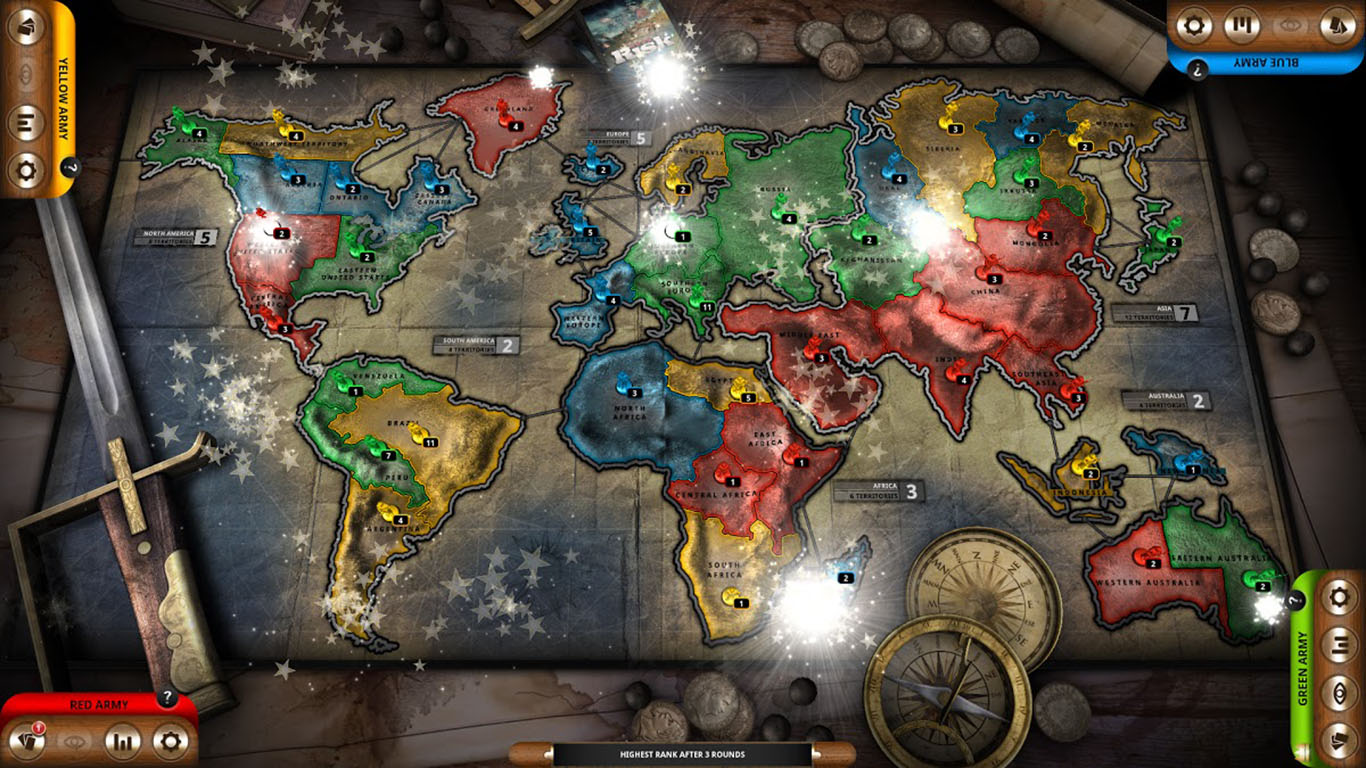

Multiplayer video game
A multiplayer video game is a video game in which more than one person can play in the same game environment at the same time, either locally (e.g. New Super Mario Bros. Wii) or online over the internet (e.g. World of Warcraft, Call Of Duty). Multiplayer games usually require players to share the resources of a single game system or use networking technology to play together over a greater distance; players may compete against one or more human contestants, work cooperatively with a human partner to achieve a common goal, or supervise other players' activity. Multiplayer games allow players interaction with other individuals in partnership, competition or rivalry, providing them with social communication absent from single-player games.
Asynchronous multiplayer[edit]
Asynchronous multiplayer is a form of multiplayer gameplay where players do not have to be playing at the same time.[1]
History[edit]
Non-networked[edit]
Some of the earliest video games were two-player games, including early sports games (such as 1958's Tennis For Two and 1972's Pong), early shooter games such as Spacewar! (1962)[2] and early racing video games such as Astro Race (1973).[3] The first examples of multiplayer real-time games were developed on the PLATO system about 1973. Multi-user games developed on this system included 1973's Empire and 1974's Spasim; the latter was an early first-person shooter. Other early video games included turn-based multiplayer modes, popular in tabletop arcade machines. In such games, play is alternated at some point (often after the loss of a life). All players' scores are often displayed onscreen so players can see their relative standing.
Gauntlet (1985) and Quartet (1986) introduced co-operative 4-player gaming to the arcades. The games had broader consoles to allow for four sets of controls.
Networked[edit]
The first large-scale serial sessions using a single computer[citation needed] were STAR (based on Star Trek), OCEAN (a battle using ships, submarines and helicopters, with players divided between two combating cities) and 1975's CAVE (based on Dungeons and Dragons), created by Christopher Caldwell (with art work and suggestions by Roger Long and assembly coding by Robert Kenney) on the University of New Hampshire's DECsystem-1090. The university's computer system had hundreds of terminals, connected (via serial lines) through cluster PDP-11s for student, teacher and staff access. The games had a program running on each terminal (for each player), sharing a segment of shared memory (known as the "high segment" in the OS TOPS-10). The games became popular, and the university often banned them because of their RAM use. STAR was based on 1974's single-user, turn-oriented BASIC program STAR, written by Michael O'Shaughnessy at UNH.
Ken Wasserman and Tim Stryker in a 1980 BYTE article identified three factors which make networked computer games appealing:[4]
- Multiple humans competing with each other instead of a computer
- Incomplete information resulting in suspense and risk-taking
- Real-time play requiring quick reaction
Wasserman and Stryker described how to network two Commodore PET computers with a cable. Their article includes a type-in, two-player Hangman, and describes the authors' more-sophisticated Flash Attack.[4]Digital Equipment Corporation distributed another multi-user version of Star Trek, Decwar, without real-time screen updating; it was widely distributed[by whom?] to universities with DECsystem-10s. In 1981 Cliff Zimmerman wrote an homage to Star Trek in MACRO-10 for DECsystem-10s and -20s using VT100-series graphics. "VTtrek" pitted four Federation players against four Klingons in a three-dimensional universe.
Flight Simulator II, released in 1986 for the Atari ST and Commodore Amiga, allowed two players to connect via modem or serial cable and fly together in a shared environment.
MIDI Maze, an early first-person shooter released in 1987 for the Atari ST, featured network multiplay through a MIDI interface before Ethernet and Internet play became common. It is considered[by whom?] the first multiplayer 3D shooter on a mainstream system, and the first network multiplayer action-game (with support for up to 16 players). There followed ports to a number of platforms (including Game Boy and Super NES) in 1991 under the title Faceball 2000, making it one of the first handheld, multi-platform first-person shooters and an early console example of the genre.[5]
Networked multiplayer gaming modes are known as "netplay". The first popular video-game title with a Local Area Network(LAN) version, 1991's Spectre for the Apple Macintosh, featured AppleTalk support for up to eight players. Spectre's popularity was partially attributed[by whom?] to the display of a player's name above their cybertank. There followed 1993's Doom, whose first network version allowed four simultaneous players.[6]
Networked multiplayer LAN games eliminate common Internet problems such as lag and anonymity, and are the focus of LAN parties. Play-by-email multiplayer games use email to communicate between computers. Other turn-based variations not requiring players to be online simultaneously are Play-by-post gaming and Play-by-Internet. Some online games are "massively multiplayer", with many players participating simultaneously. Two massively-multiplayer genres are MMORPG (such as World of Warcraft or EverQuest) and MMORTS.
Some networked multiplayer games, including MUDs and massively multiplayer online games (MMOG) such as RuneScape, omit a single-player mode. First-person shooters have become popular multiplayer games; Battlefield 1942 and Counter-Strike have little (or no) single-player gameplay. Developer and gaming site OMGPOP's library includes multiplayer Flash games for the casual player. The world's largest MMOG is South Korea's Lineage, with 19 million registered players (primarily in Asia).[7] The largest Western MMOG in 2008 was World of Warcraft, with over 10 million registered players worldwide. This category of games requires multiple machines to connect via the Internet; before the Internet became popular, MUDs were played on time-sharing computer systems and games like Doom were played on a LAN.
During the 2010s, as the number of Internet users increased, two new video game genres rapidly gained worldwide popularity – multiplayer online battle arena and battle royale game, both designed exclusively for multiplayer gameplay over the Internet.
Gamers refer to latency using the term "ping", after a utility which measures round-trip network communication delays (by the use of ICMP packets). A player on a DSL connection with a 50-ms ping can react faster than a modem user with a 350-ms average latency. Other problems include packet loss and choke, which can prevent a player from "registering" their actions with a server. In first-person shooters, this problem appears when bullets hit the enemy without damage. The player's connection is not the only factor; some servers are slower than others.
Beginning with the Sega NetLink in 1996, Game.com in 1997 and Dreamcast in 2000, game consoles support network gaming over LANs and the Internet. Many mobile phones and handheld consoles also offer wireless gaming with Bluetooth (or similar) technology. By the early 2010s online gaming had become a mainstay of console platforms such as Xbox and PlayStation.[citation needed]
Single-system[edit]
In modern console, arcade and personal computer games, "multiplayer" implies play with several controllers plugged into one game system. Home-console games often use split screen, so each player has an individual view of the action (important in first-person shooters and in racing video games); most arcade games, and some console games (since Pong), do not. Nearly all multiplayer modes on beat 'em up games have a single-system option, but racing games have started to abandon split screen in favor of a multiple-system, multiplayer mode. Turn-based games such as chess also lend themselves to single system single screen and even to a single controller.
The term "local co-op" refers to local multiplayer games played in a cooperative manner on the same system; these may use split-screen or some other display method.
Hotseat games are typically turn-based games with only one controller or input set - such as a single keyboard/mouse on the system. Players rotate using the input device to perform their turn such that each is taking a turn on the "hotseat".
Asymmetrical gameplay[edit]
Asymmetrical multiplayer is a type of gameplay in which players can have significantly different roles or abilities from each other; enough to provide a significantly different experience of the game. In games with "soft asymmetry", the players have the same basic mechanics (such as movement and death), yet have different roles in the game. In "strong asymmetry" games, one player/team may have one gameplay experience (or be in softly asymmetric roles) while the other player/team play in a drastically different way, with different mechanics and/or a different type of objective.
Online cheating[edit]
Online cheating (in gaming) usually refers to modifying the game experience to give one player an advantage over others such as Aimbot in shooting games.[8][9][10] This is also known as "hacking" or "glitching" (Note that "glitching" refers to using a glitch, or a mistake in the code of a game, where as "hacking" is manipulating the code of a game). Cheating in video games is often done via a third party program which modifies the game's code at runtime to give one or more players an advantage. In other situations, it is frequently done by changing the games files to change the game's mechanics.[11]
See also[edit]
References[edit]
- ^Kelly, Tadhg. "Opinion: Synchronous or Asynchronous Gameplay".
- ^"Getting Connected". Next Generation. No. 19. Imagine Media. July 1996. p. 29.
- ^Astro Race at the Killer List of Videogames
- ^ abWasserman, Ken; Stryker, Tim (December 1980). "Multimachine Games". BYTE. p. 24. Retrieved 18 October 2013.
- ^Parish, Jeremy, The Essential 50: Faceball 2000Archived 2004-08-20 at the Wayback Machine, 1UP, Accessed April 24, 2009
- ^"Doom - electronic game".
- ^"NCsoft's Lineage II Expansion Dramatically Speeds Up Character Progression - IGN". Ca.ign.com. Retrieved 2013-08-28.
- ^"Cheating". Dictionary.com. Retrieved December 19, 2012.
- ^Thompson, Clive (December 19, 2012). "What Type of Game Cheater Are You?". Wired.com. Retrieved 2009-09-15.
- ^"How To Hurt The Hackers". Retrieved June 1, 2017.
- ^Carter, M. & Gibbs, M. (2013) “eSports in EVE Online: Skullduggery, Fair Play and Acceptability in an Unbounded Competition.” In Proceedings of FDG’13. ACM

-
-